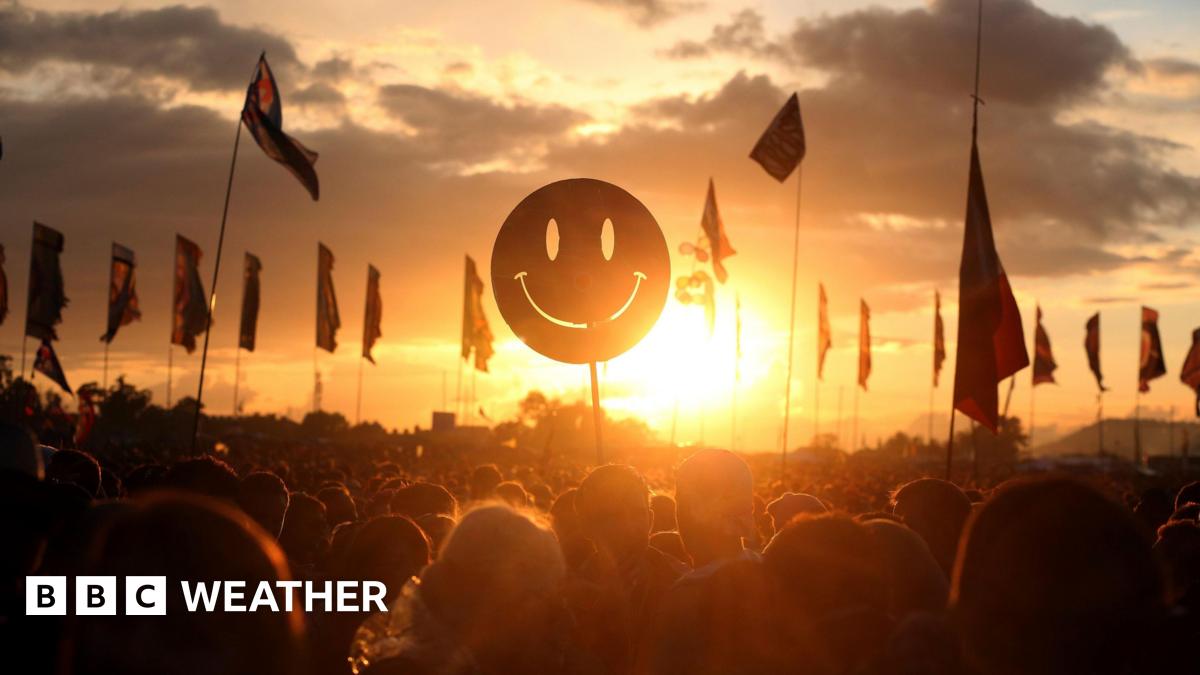With high pressure currently across the UK, the run up to the Glastonbury Festival is looking dry, settled and very warm. But it's much harder to say what will happen beyond this coming weekend and if the heat and sunshine will last. If you've been lucky enough to bag yourself tickets and are wondering what to pack, this year it may be a case of sun cream AND wellies. But for hardened festival goers, rain or shine, it's always been as much about the experience as the music. By the end of this week temperatures will rise to well above the June average, forecast to hit 28C in nearby Pilton, Somerset. It will feel warm at night too with temperatures not dropping below the mid-teens. However, by the middle of next week - just in time for the start of the festival - things could start to turn cooler with temperatures forecast to be in the low twenties. There is the possibility that there could be some rain, particularly early on. It may then turn drier into the weekend along with some sunshine as big names such as The 1975 and Alanis Morrissette take to the stage on Friday and again on Saturday for acts like the Kaiser Chiefs and Raye. Patchy rain is currently in the forecast for Sunday for Rod Stewart's "Legends" slot and Olivia Rodrigo later in the evening. At this stage it's very difficult to give any detail or certainty so keep an eye on theBBC forecast online, on the app, onInstagram,externaland onX,external. How hot is too hot? From heat labs to firefighting helicopter pilots and wineries, we look at how extreme heat impacts people and environments in the UK. Last year there were some sunny spells, some patchy rain, average temperatures with neither mud nor blazing heat - pretty similar to what may be in store weather-wise for this year. Looking back on years gone by the warmest was in 2017 when the mercury hit a scorching 31.7C (89F). The joint windiest was in 1987 with tent-destroying gusts of more than 40mph (64km/h). This was also the year with the chilliest night - just 4.2C at nearly Yeovilton. Tent City during the 'Year of the Mud' of 1997. Torrential rain fell in the days before the festival began Who could forget 1997 - known as the Year of the Mud. It was the height of Britpop with the Prodigy, Radiohead and Sting performing. The early British summer brought six out of eight days of rain in the run up to the festival. The gloop was knee-deep and mud pits formed next to the main stage. Ten years later in 2007, with the Arctic Monkeys, the Who and The Killers headlining, it was the wettest year in the festival's history. More than a month's worth of rain 60.1mm (2.37in) fell on the Friday and into the weekend. The site turned into a mud bath once more with tents floating on liquid earth. Some embraced the challenge, many went home early. Come rain or shine the best way to find out how conditions are shaping up for Glastonbury 2025 is to stay in touch withBBC Weather.
Will the warm weather last for Glastonbury Festival?
TruthLens AI Suggested Headline:
"Uncertain Weather Forecast for Upcoming Glastonbury Festival"
TruthLens AI Summary
As the Glastonbury Festival approaches, the weather forecast for the UK is currently promising with high pressure leading to dry, settled, and warm conditions. This week, temperatures are expected to rise significantly, surpassing the June average and potentially reaching 28°C in Pilton, Somerset. Festival attendees are advised to prepare for both sun and possible rain, suggesting they pack sunscreen alongside wellington boots. The warm weather is anticipated to continue into the nights, with temperatures remaining in the mid-teens. However, forecasts indicate a shift in weather patterns by the middle of next week, coinciding with the festival's start. While the early days may bring cooler temperatures in the low twenties, there is also a chance of rain, particularly during the opening days of the festival, before drier conditions and sunshine are expected to return for the weekend performances by major artists like The 1975 and Alanis Morissette.
Historically, Glastonbury has seen a variety of weather conditions, from scorching heat to torrential rain, contributing to its legendary status. The warmest festival on record occurred in 2017 when temperatures reached 31.7°C, while 1987 was noted for its strong winds. The notorious 'Year of the Mud' in 1997 saw knee-deep mud due to rain leading up to the event, while 2007 experienced record rainfall, transforming the site into a mud bath. These memories underscore the unpredictable nature of the British summer and the festival experience. As the festival nears, attendees are encouraged to stay updated with the latest forecasts from the BBC to ensure they are prepared for any weather that may arise during the event.
TruthLens AI Analysis
You need to be a member to generate the AI analysis for this article.
Log In to Generate AnalysisNot a member yet? Register for free.
